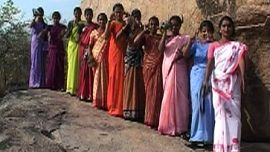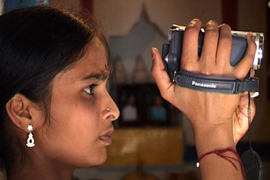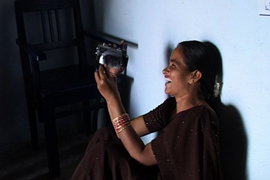
Filmmaker’s view: Sari Stories
A unique film made by, with and about four women in rural Southern India.
Sari Stories looks at a group of women from rural Southern India being trained as video journalists as part of an initiative to alleviate rural poverty.
Keep reading
list of 4 itemsInside the pressures facing Quebec’s billion-dollar maple syrup industry
‘Accepted in both [worlds]’: Indonesia’s Chinese Muslims prepare for Eid
Photos: Mexico, US, Canada mesmerised by rare total solar eclipse
In the following account, filmmaker Sue Sudbury describes the making of Sari Stories.
I first read about the Sneha Praja Video Project on the video volunteers website.
Video volunteers is an US charity, run by Jessica Mayberry, which has pioneered the production of video news magazine programmes in developing countries.
| In depth |
|
|
It has set up 12 video units, with around 100 people working full time in slums and villages as community producers.
The films have then been shown to more than 200,000 people in 800 community screenings.
I was fascinated by this particular project in Andhra Pradesh in Southern India and wanted to find out more about the women involved and the films they were making.
India, with its booming economy, its rapidly growing middle class, and Bollywood is supposed to be a global succcess story. But I knew that there is another side of this vibrant nation – the vast majority of Indians still live in poverty.
I travelled to India and met Meera Shenoy, who was in charge of the project in India and one of the key people who set it up. She took me to the training centre where I met the women video reporters.
The women come from villages all over Andhra Pradesh and some of them had travelled for over four hours on a local bus to take part in the training and video project.
Before the joined the project, they lived traditional lives as wives and mothers, working in the fields for a few rupees a day, far away from the new dynamic India.
Part two:
Child brides
After their training, the women decide to make their first community film about the problems of child marriage.
“We chose the subject of child marriage because we were child brides ourselves and we suffered a lot,” Vinodha says, and starts the video report: “Child marriages continue in our villages. The lives of many girls are sacrificed. Children who marry young not only have to face the harassment of their in-laws but also have to bear the assaults of their husbands.”
They tell me that society does not approve of a wife leaving her husband, and most women refuse to move back to their families, even if their family offers help.
 |
| For Latha and the other women taking part in the project, the camera is like a weapon |
But Latha eventually decided to leave her husband for the sake of her son. “My husband would get drunk and blow smoke in his face.”
“I realised if my child grew up in that environment he would become like this himself,” she says.
Despite opposition from the men in their villages, the women are finding a voice through their films.
They learned how to shoot, interview, script and direct community video’s, and these new skills, plus the confidence they have gained, have empowered and transformed their lives.
The women hope that their video helps people realise that child marriage is illegal and that the girls should get an education instead of being married at the age of 12. But they know that some people won’t take it seriously and will go on living the traditional rural life.
Everyday life in rural India
Sari Stories is only partly about this community video project.
I decided that it would be interesting to ask four of the women if they would also use their cameras to show us their everyday lives.
I asked them to film whatever they wanted to and whatever they felt was important.
We are taken into their homes, to meet their families, to witness their quarrels and to share the intimacy of their everyday life.
We are given a glimpse of the reality of life in remote rural villages previously unseen by a Western audience.
 |
| Parvati is filming her husband while questioning him about her taking part in the project |
There are some very amusing moments when Parvati decides to question her husband on camera about where he had been and why he didn’t turn up for lunch.
Indira uses her camera to question her husband about his feelings about her taking part in the community video project.
She feels that he hasn’t always supported her partition in the project and was determined to get him to admit this on camera.
She keeps interviewing him until eventually he is more open with his thoughts.
I think this aspect of the film gives a truly unique insight into life in rural India today and takes us into their homes in a way that I could not have achieved with my camera alone.
I also asked the women to make video diaries. When Indira started to talk to the camera she began to cry.
I was concerned as to what was making her upset but Jayasree, our translator, said Indira was saying that she was so happy to have the chance of expressing her thoughts for the first time so publicly.
At another moment, Parvati also cried while talking to camera and this made Jayasree cry too. Later he told us that Parvati was talking about how her son had died.
This film could not have happened without the collaboration of these women from the Sneha Praja Video project – in particular Latha, Vinodha, Parvati and Indira and their families – and I am so thankful to them for taking part in the film.
I am still in touch with them and hope to work with them again in the future.
The community project has now come to an end, but the women are already putting their new skills to work. They are now being paid to film government meetings, and this is continuing to change their lives.
The views expressed in this article are the author’s own and do not necessarily reflect Al Jazeera’s editorial policy.
Sari Stories can be seen from Tuesday, March 9, 2010 at the following times GMT: Tuesday: 0830, 1900; Wednesday: 0330, 1400, 2330.

 Watch more Witness documentaries
Watch more Witness documentaries